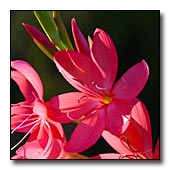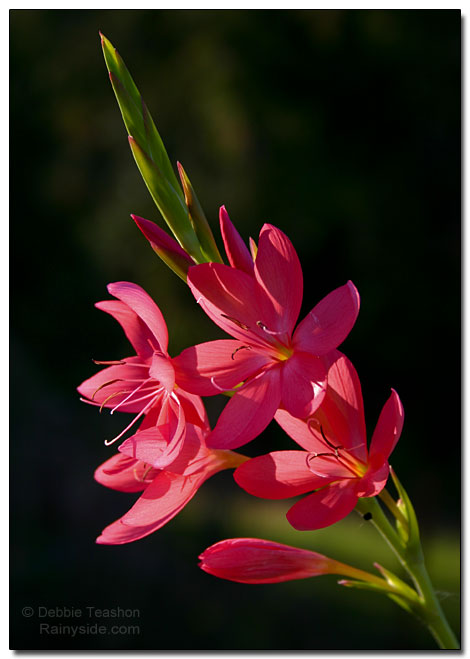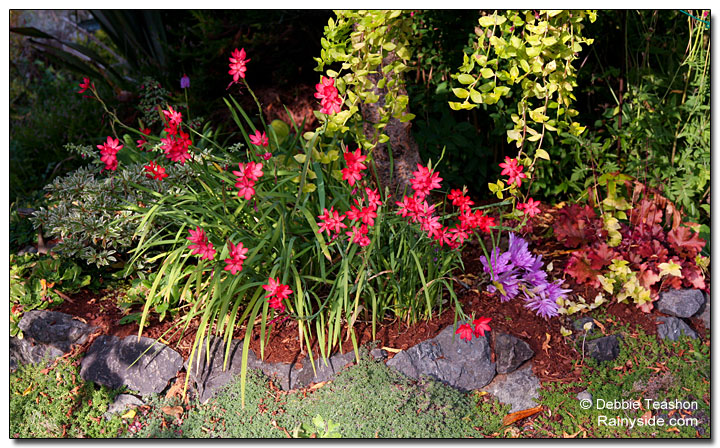Hesperantha coccinea
'Oregon Sunset'
CRIMSON FLAG, COFFEE LILY, RIVER LILY, SCARLET RIVER LILY
syn. Schizostylis, coccinea
Family: Iridaceae
Pronounced: hes-per-ANTH-uh kok-SIN-ee-uh

Quick Jumps
Growing Guide
Rainy Side Notes
GROWING GUIDE

Origin:
Garden.
Plant Group:
Bulbs.
Hardiness:
Sunset zones: 5-9, 14-24; H1, H2.
USDA zones: 7-9.
Heat zones: 9-7.
Mature size:
Height: 24 inches (60 cm).
Width: 12 inches (30 cm).
Flowering period:
Late summer through early winter.
Flowering attributes:
Spikes of scarlet, 3/4-inch, cup-shaped flowers grow along a long stem—gladiolus style.
Leaf attributes:
Evergreen, sword-like leaves.
Growth habit:
Clump forming.
Light:
Full sun to partial shade.
Soil:
Moist to wet, fertile, humus rich soil.
Feeding:
Side dress with compost or manure. Fertilize in spring, again in early summer, and when the flowers begin to show color in fall, with a complete organic fertilizer.
Propagation Methods:
Divide in early spring.
Pruning Methods:
Prune off dead leaves throughout the growing season to keep the plant looking good.
Pests and Diseases:
No problems noted.
Rainy Side Notes

As beautiful as an October sunset, easy to grow and abundant in bloom in fall and winter, Hesperantha 'Oregon Sunset' puts color back into our drab gray winter. It's even fierier when backlit by a low winter sun. Isn't it surprising we don't see it growing in every Northwest garden?
This plant has more names than a serial divorcé. Its popular common name in North America and Britain is kaffir lily. In other parts of the world, kaffir is a racial slur; because of this, many call the plant by its numerous other names, as am I. Besides, its newest botanical name is fun to say—hesper-ANTH-uh. I feel like I'm hissing and lisping all in the same breath.
More name confusion comes from changing its name from Schizostylis, with only one species in the genus, to Hesperantha. The reason for the change was noted in 1996 in NOVON vol 6 no. 3 (1996). "Drs Goldblatt and Manning sank Schizostylis coccinea into Hesperantha as Hesperantha coccinea because the reversion to a rhizome was no more than an adaptation to a wet habitat and the long tubed red flower catered to its pollinator Aeropetes tulbaghia. Both adaptations are not uncommon in the Iridaceae: Ixioideae. There being no other morphological distinction between Schizostylis and Hesperantha, there seems to be no good reason for maintaining a monospecific genus. This is in line with the modern trend to discourage monospecifics which apart from environmental (even if visually obvious) adaptations, do not differ essentially from established and multi-specific genera."
The evergreen cultivar and the species make excellent cut flowers that last a long time in the vase. The best part about growing this plant is it can bloom as early as August and keep flowering well into early winter, even into February during mild winters.
Although easy to grow, they like extra moisture during our drought and fertile soil. The crimson flag will spread, yet it does it with so much grace that you hate to lift them out of an area they wish to colonize. Ann Lovejoy noted, "...once established, they are yours for life." She is right; let the roots settle in the first year. Then, stand back and enjoy the fall and winter show.
To see this bright scarlet flower blooming in the fall is a treat, yet it is worthy of long sonatas about its brilliant winter hues during the darkest part of the year.
Photographed in author's garden.
A Pacific Northwest Plant of the Week (2011)

Gardening for the Homebrewer: Grow and Process Plants for Making Beer, Wine, Gruit, Cider, Perry, and More
By co-authors Debbie Teashon (Rainy Side Gardeners) and Wendy Tweton
Copyright Notice | Home | Search | Bulbs

